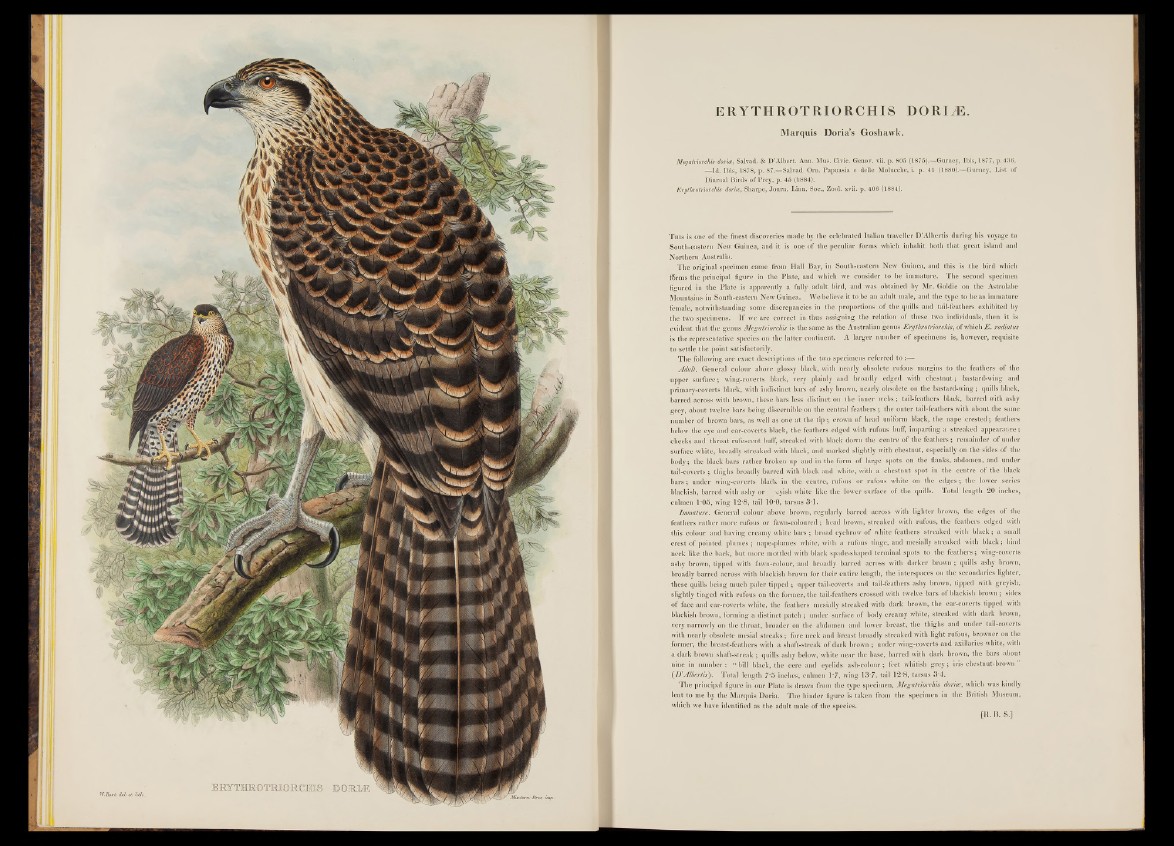
ERYTHROTRIORCHIS DORIÆ.
Marquis Doria’s Goshawk.
Megatriorchis doria, Salvad. & D’Albert. Ann. Mus. Civic. Genov, vii. p. 805 (1875).— Gurney, Ibis, 1877, p. 436.
— Id. Ibis, 1878, p. 87.— Salvad. Orn. Papuasia e delle Molucche, i. p. 41 (1880).— Gurney, List of
Diurnal Birds o f Prey, p. 45 (1884).
Erythrotriorchis doria, Sharpe, Journ. Linn. Soc., Zopl. xvii. p. 406 (1884).
T h is is one o f the finest discoveries made by the celebrated Italian traveller D ’Albertis during his voyage to
South-eastern New Guinea, and it is one of the peculiar forms which inhabit both that great island and
Northern Australia.
The original specimen came from Hall Bay, in South-eastern New Guinea, and this is the bird which
fSrms the principal figure in the Plate, and which we consider to be immature. The second specimen
figured in the Plate is apparently a fully adult bird, and was obtained by Mr. Goldie on the Astrolabe
Mountains in South-eastern New Guinea. We believe it to be an adult male, and the type to be an immature
female, notwithstanding some discrepancies in the proportions of the quills and tail-feathers exhibited by
the two specimens. If we are correct in thus assigning the relation o f these two individuals, then it is
evident that the genus Megatriorchis is the same as the Australian genus Erythrotriorchis, o f which E . radiatus
is the representative species on the latter continent. A larger number o f specimens is, however, requisite
to settle the point satisfactorily.
The following are exact descriptions o f the two specimens referred to ^
Adult. General colpur above glossy black, with nearly obsolete rufous margins to the feathers o f the
upper surface ; wing-coverts black, very plainly and broadly edged with chestnut ; bastard-wing and
primary-eoverts black, with indistinct bars o f ashy brown, nearly obsolete on the bastard-wing ; quills black,
barred across with brown, these bars less distinct on the inner webs ; tail-feathers black, barred with ashy
grey, about twelve bars being discernible on the central feathers ; the outer tail-feathers with about the same
number of brown bars, as well as one at the tip ; crown o f head uniform black, the nape crested ; feathers
below the eye and ear-coverts black, the feathers edged with rufous buff, imparting a streaked appearance;
cheeks and throat rufescent huff, streaked with black down the centre o f the feathers ; remainder o f under
surface white, broadly streaked with black, and marked slightly with chestnut, especially on the sides of the
body ; the black hairs rather broken up and in the form o f large spots on the flanks, abdomen, and under
tail-coverts ; thighs broadly barred with black and white, with a chestnut spot in the centre of the black
bars ; under wing-coverts black in the centre, rufous or rufous white on thé edges ; the lower series
blackish, barred with ashy or cyish white like the lower surface o f the quills. Total length 20 inches,
culmen 1'05, wing 12*8, tail 10‘0, tarsus 3 ‘1.
Immature. General colour above brown, regularly barred across with lighter brown, the edges o f the
feathers rather more rufous or fawn-coloured ; head brown, streaked with rufous, the feathers edged with
this colour and having creamy white bars ; broad eyebrow o f white feathers streaked with black ; a small
crest o f pointed plumes; nape-plumes white, with a rufous tinge, and mesially streaked with black; hind
neck like the back, but more mottled with black spade-shaped terminal spots to the feathers ; wing-coverts
ashy brown, tipped with fawn-colour, and broadly barred across with darker brown ; quills ashy brown,
broadly barred across with blackish brown for their entire length, the interspaces on the secondaries lighter,
these quills being much paler tipped ; upper tail-coverts and tail-feathers ashy brown, tipped with greyish,
slightly tinged with rufous on the former, the tail-feathers crossed with twelve bars of blackish brown ; sides
o f face and ear-coverts white, the feathers mesially streaked with dark brown, the ear-coverts tipped with
blackish brown, forming a distinct patch ; under surface o f body creamy white, streaked with dark brown,
very narrowly on the throat, broader on the abdomen and lower breast, the thighs and under tail-coverts
with nearly obsolete mesial streaks ; fore neck and breast broadly streaked with light rufous, browner on the
former, the breast-feathers with a shaft-streak o f dark brown ; under wing-coverts and axillaries white, with
a dark brown shaft-streak ; quills ashy below, white near the base, barred with dark brown, the bars about
nine in number : “ bill black, the cere and eyelids ash-colour ; feet whitish grey ; iris chestnut-brown ”
(jyAlbertis'). Total length 7'5 inches, culmen 1*7, wing 13'7, tail 12-8, tarsus 3 ’4.
The principal figure in our Plate is drawn from the type specimen, Megatriorchis dorioe, which was kindly
lent to me by the Marquis Doria. The hinder figure is taken from the specimen in the British Museum,
which we have identified as the adult male o f the species.
[R. B. S.]